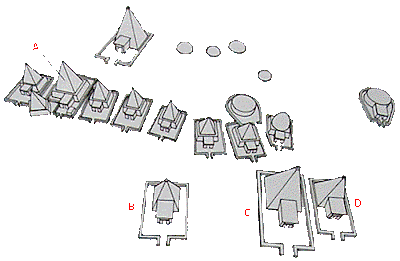The stones are disks inscribed with text allegedly describing the crash-landing of an alien craft in Tibet thousands of years ago.
In 1938, according to one source, Chi Pu Tei, a professor of archaeology at Beijing University, and his students were on an expedition to explore a series of caves in the Himalayan mountains of the remote Bayan-Kara-Ula range on the border of China and Tibet. The caves appeared to have been artificially carved into a system of tunnels and underground storerooms. It is alleged that the walls were squared and glazed, as if artificially cut into the mountain with great heat.
The explorers are said to have found many neat rows of tombs with short 138 cm skeletons buried within. The skeletons had abnormally big heads, and small, thin, fragile bodies. A member of the team suggested that these might be the remains of an unknown species of mountain gorilla. Prof. Chi Pu Tei was said to respond, "Whoever heard of apes burying one another?"
There were no epitaphs at the graves, but instead hundreds of 30 cm wide stone discs were found having 20 mm wide holes in their centers (the Dropa Stones). On the walls were carved pictures of the rising sun, moon, stars, the land, mountains, and lines of pea-sized dots connecting Earth with its sky. Along with the discs, the cave drawings were determined to be about 12 000 years old.
While studying the skeletons one of the members of the team stumbled on a large round stone disc half buried in the dust on the floor of the cave.
The disk was approximately nine inches in diameter and three-quarters of an inch thick. In the exact center was a perfectly round, 3/4" hole, and etched in its face was a fine groove spiraling out from the center to the rim, making the disk look for all the world like some kind of primitive phonograph record.
No one understood the meanings of the message. The disc was labeled and filed away among other finds in the area. For 20 years many experts in Peking tried to translate the disc. When the disks were closely examined by Dr. Tsum Um Nui of Beijing around 1958, he concluded that each groove actually consisted of a series of tiny hieroglyphs of unknown pattern and origin. The hieroglyphs were small and apparently needed a magnifying glass to see them clearly. Many of the hieroglyphics had been worn away by erosion. Finally Dr. Tsum Um Nui broke the code and started to decipher the "speaking grooves". Dr. Tsum is said to have deciphered the symbols, alleging they told the story of the crash-landing of a spaceship and the killing of most of the survivors by local people.Dr. Tsum's report supposedly appeared in a professional journal in 1962. He was allegedly ridiculed to the point of self-imposed exile in Japan, where he died. The Peking Academy of Pre-History never allowed him to publish or speak of his findings again.
716 more grooved stone discs were uncovered in the same caves. They told the story of a "space probe" by the inhabitants of another planet who came to the Baya-Kara-Ula mountain range. They had crash landed. Their peaceful intentions had been misinterpreted. Many of them had been hunted down and killed by members of the Han tribe, who lived in the neighboring caves.
They referred to themselves as the Dropas. They said they came down from the clouds in their space craft. It crashed landed in remote and inaccessible mountains. There was no way to build a new ship. Legend in the area spoke of small gaunt yellow faced men who came from the clouds long ago. The men had huge bulging heads and small bodies. They were so ugly they were hunted down and killed. This description is similar to the bodies found in the caves. On the walls of the caves archaeologists found crude pictures of the rising Sun, the Moon, unidentifiable stars and the earth all joined together by lines of pea-sized dots. The cave drawings have been dated around 12,000 years ago.
---
Nubia was a reservoir of royal pyramids long after the had ceased to be built in Egypt itself. Above the IIIrd cataract the principle pyramid cementeries at el-Kurru, Gebel Barkal, Nuri and Meroe, were built about 180 pyramids. The Nubian sequence begins more than 800 years after the last royal pyramid was built in Egypt.
SOURCE 1
SOURCE 2
